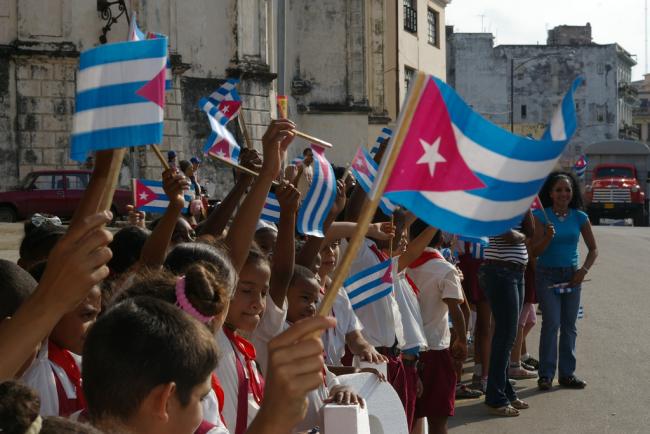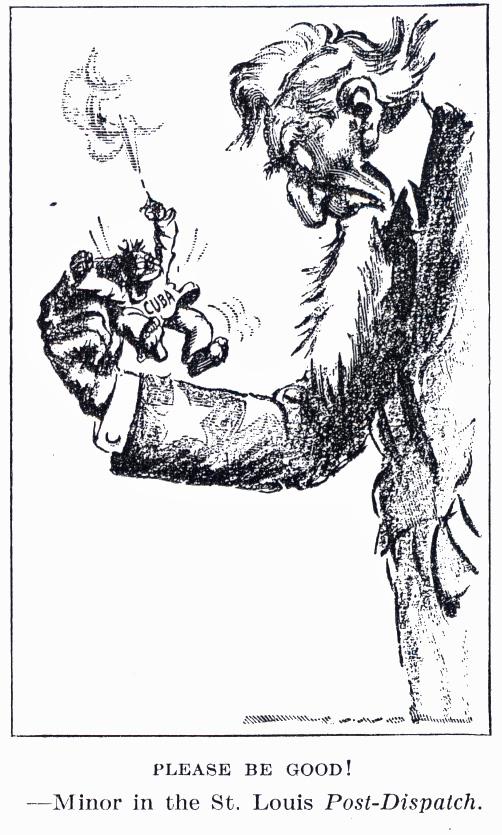
Thursday marks one year since Raúl Castro and Barack Obama announced the restoration of diplomatic ties between Cuba and the US after a half century of hostility. It was, by most accounts, a "historic" moment, followed in the ensuing months by events long dismissed as impossible: reopened embassies, presidential handshakes, new trade and travel opportunities. But one year after "D17," some of the most difficult questions shaping the future of Cuba-US relations remain not just unanswered but fundamentally unaddressed - what will become of the embargo? Will U.S. efforts to steer Cuban politics and society at last bear fruit? In this first of a two-part report, the historian and renowned Cuba scholar Louis Pérez, Jr. sets the "historic" against the backdrop of history to ask: what, in fact, has changed in Cuba-US relations? Professor Pérez's final installment can be found here:
- The Editors
Expectations soared on December 17, 2014: “Sweeping changes ushering in a transformational era,” exulted the New York Times. “A truly historic moment,” pronounced the Huffington Post. Archbishop Thomas G. Wenski of the Archdiocese of Miami rejoiced over the “game changer” announcements, and the Brookings Institution predicted “seismic change” in the offing. A “bold new policy,” proclaimed the Chicago Tribune.
That the joint announcements in Havana and Washington on December 17 portended change could hardly be gainsaid, of course. Some things did indeed change. Cubans and Americans, at the highest levels of government, were speaking to each other – instead of at each other. That was something. To re-open embassies in Havana and Washington: that was something too. All to the good, of course. Assistant Secretary of State Roberta Jacobson was most assuredly correct to note that “diplomatic relations and having embassies is incredibly important in a relationship like this where you have so much to overcome and where you have differences.” Given the long dismal state of affairs between Cuba and the United States, resumption of diplomatic relations could not be seen in any way other than the most salutary development since the establishment of Interests Sections in 1977. The change of policy was welcomed.
But it’s also true that some things had not changed, and therein lurked the specter of a past foretold, for much of what had not changed was precisely what had been at the source of the rupture of the past 55 years. An old politics appeared in the guise of new policy. These are times to contemplate an unfolding history as a cautionary tale, a time from which to divine present purpose from the past.
The Cuba-U.S. estrangement began early. It didn’t take long at all – less than 10 months, in fact – for the U.S. State Department to conclude that it was “unrealistic to assume that we shall ever be able to do business with the Castro Government on a basis which could be termed even reasonably satisfactory.” Six months later, the United States had committed itself to a policy of regime change in Cuba.
The policy was pursued with a single-minded resolve: through political isolation, an armed invasion, countless numbers of assassination plots, years of covert operations, and decades of punitive economic sanctions. All in all, a 55-year-old policy given to the overthrow of the Cuban government – or perhaps more correctly, given to the creation of conditions that would produce the overthrow of the Cuban government.
Of all the methods devised to obtain a change of regime, none seemed as compelling as the use of political isolation and economic sanctions. Officially designated as an “economic denial program,” sanctions expanded into a full-blown policy protocol designed to induce economic hardship in Cuba. It should not be supposed that the Cuban people were unintended “collateral damage” of U.S. policy. On the contrary, the Cuban people were the target. Cubans were held responsible for, and made to bear the consequences of, the programs and policies of their government. “For all practical purposes, we are now in virtual open conflict with the Castro government,” Assistant Secretary of State R. Roy Rubottom concluded by mid-1960.
“We have gone as far as we can in trying to distinguish between the Cuban people and their present government, much as we sympathize with the plight of what we believe to be the great majority of Cubans… [T]he Cuban ‘people’ have allowed themselves to be hoodwinked and out-maneuvered, assuming that some of them have been alert, by the communists.”
Undersecretary of State Douglas Dillon agreed, and endorsed policies designed to have a “serious effect on the Cuban people,” noting: “We need not be so careful about actions of this kind [i.e., sanctions], since the Cuban people [are] responsible for the regime.”
Sanctions were designed to produce economic havoc as a way to promote popular discontent, to inflict adversity as a permanent condition of daily life. They were meant to “exert a serious pressure on the Cuban economy and contribute to the growing dissatisfaction and unrest in the country,” Assistant Secretary of State Thomas Mann explained. That is, U.S. sanctions were intended to politicize hunger with the expectation that, driven by despair and motivated by want, the Cuban people would rise up against the Castro government. “If they [the Cuban people] are hungry,” President Dwight Eisenhower predicted confidently, “they will throw Castro out.”

The intent was to “weaken [the Castro government] economically,” explained one State Department briefing paper, to “promote internal dissension; erode its internal political support . . . [and] seek to create conditions conducive to incipient rebellion.” Sanctions were designed to create “the necessary preconditions for nationalist upheaval inside Cuba,” the State Department Bureau of Intelligence and Research explained, to obtain the downfall of the Castro government “as a result of internal stresses and in response to forces largely, if not wholly, unattributable to the U.S.” The idea was to use “economic pressures . . . in order to engender more public discomfort and discontent,” explained Assistant Secretary Rubottom, in the form of “a relentless, firm pressure, [and] a steady turning of the screw.” The “only foreseeable means of alienating internal support,” Deputy Assistant Secretary of State Lester Mallory concluded in 1960, “is through disenchantment and disaffection based on economic dissatisfaction and hardship.” Mallory recommended that “every possible means should be undertaken promptly to weaken the economic life of Cuba, . . . [to deny] money and supplies to Cuba, to decrease monetary and real wages, to bring about hunger, desperation and [the] overthrow of government.”
Punitive sanctions were meant to deliver a message, a way to “inform” the Cuban people that relief from U.S.-induced hardship would not be forthcoming until they had bestirred themselves to remove Fidel Castro. The “primary objective” of U.S. policy, Eisenhower emphasized was “to establish conditions which will bring home to the Cuban people the cost of Castro’s policies and of his Soviet orientation.” The President continued:
“I anticipate that, as the situation unfolds, we shall be obliged to take further economic measures which will have the effect of impressing on the Cuban people the cost of this communist orientation. We hope, naturally, that these measures will not be so drastic or irreversible that they will permanently impair the basic mutuality of interests of Cuba and this country.”
Covert operations against Cuba during the 1960s were planned in coordination with the economic denial program, principally by laying siege to the infrastructure of the Cuban economy through the infiltration of sabotage teams assigned to disrupt Cuban agriculture and disorganize industry. The Central Intelligence Agency planned a “strategy of economic strangulation to weaken and undermine the regime,” to “tighten the economic noose around Castro” in order to create “economic chaos” based on “efforts to destroy the Cuban economy by sabotage, sanctions, and other measures of economic warfare.” General Edward Lansdale, charged with the coordination of sabotage against the Cuban economy, explained the objectives of covert operations this way:
“Basically, the [covert] operation is to bring about the revolt of the Cuban people. The revolt will overthrow the Communist regime and institute a new government with which the United States can live in peace …The political actions will be assisted by economic warfare to induce failure of the Communist regime to supply Cuba’s economic needs, [and] psychological operations to turn the people’s resentment against the regime.”
By the mid-1960s, the CIA could speak of a “concept of the covert action plan,” including “covert economic denial operations . . . designed to reinforce and be reinforced by our overt measures of economic pressure. Both types of activities directed against the economy are intended to aggravate existing economic difficulties and thus to increase the level of disaffection not only in the popular mass but particularly in the power centers of the regime.” Covert operations contemplated a program of “economic warfare to induce failure of the Communist regime to supply Cuba’s economic needs,” thereby “to bring about the revolt of the Cuban people [and] to turn the peoples’ resentment increasingly against the regime.”
Infiltration teams sabotaged specific sectors of the economy. “Our covert activities,” presidential advisor Richard Goodwin reported to President John Kennedy in 1961, “would now be directed toward the destruction of targets important to the economy, e.g., refineries, plants using U.S. equipment, etc.”
Four key sectors of the Cuban economy were targeted: electric power facilities, including the destruction of electric generating plants; petroleum refineries, storage facilities, and tankers; railroad and transportation systems, including bridges, railroad tracks, and rolling stock as well as port, shipping, and maritime facilities; and production and manufacturing sectors, including the industrial facilities, sugar cane fields and mills, and communication systems. Particular attention was given to sugar production, a way to undermine the island’s principal source of foreign exchange. Covert operations included arson of cane fields, sabotage of machinery, and acts of chemical warfare, including the spreading of chemicals in sugar cane fields to sicken Cuban cane cutters. During the late 1960s, the UPI reported that the United States engaged in seeding clouds to induce drought conditions as a means to ruin the Cuban sugar harvest.
In the years that followed, successive U.S. administrations devised new means and designed new methods to deepen economic hardship. The administration of Ronald Reagan introduced new restrictions on U.S. travel to Cuba, suspending U.S. tourism to deprive the island of a key source of foreign exchange. The United States maneuvered behind the scenes to make Cuban foreign debt negotiations as difficult as possible. U.S. corporations operating in third countries were pressured to suspend trade with Cuba; new limits were placed on cash and gifts Cuban residents in the United States were able to send to the island. In 1982, the Reagan administration placed Cuba on its list of state sponsors of terrorism, further complicating Cuban financial and commercial transactions.
The collapse of the Soviet Union in 1991 resulted in economic calamity in Cuba–optimal conditions, the Americans were persuaded, to deliver the coup de grâce to the faltering Castro government. The enactment of the Torricelli Law (1992) and the Helms-Burton Law (1996) expanded the scope and increased the severity of sanctions. The Torricelli law prohibited subsidiaries of U.S. corporations in third countries from trading with Cuba and authorized the President to withhold U.S. foreign aid, debt relief, and free trade agreements with countries that provided assistance to Cuba. All ships trading with Cuba were denied access to U.S. port facilities for a period of 180 days after having visited Cuba.
Amendments to the Cuban Assets Control Regulations prohibited travellers from returning to the United States with Cuban cigars and rum for personal use. Cuban-American spending on travel-related fees charged by the Cuban government was limited to an annual maximum of $500. The United States reduced the humanitarian aid packages U.S. citizens could send to Cuba. Luggage weight to Cuba was restricted to a maximum of 44 pounds per traveller, with no paid excess baggage permitted. These latter measures were especially harsh, for they limited the much needed clothing and miscellaneous consumer goods often carried by visiting family members.“My objective is to wreak havoc in Cuba… My task is to bring down Fidel Castro,” Representative Robert Torricelli blustered.
Helms-Burton expanded U.S. sanctions into domains of extra-territorial overreach, stipulating punishment of foreign companies, governments, and lending institutions that engaged in business transactions with, or provided financial services to, Cuba. It banned sugar products from countries that imported Cuban sugar and denied entry to third-country citizens who engaged in business involving previously nationalized U.S. properties. Helms-Burton converted a policy into a law, making economic sanctions a permanent condition until a “transition government” undertook verifiable steps toward the establishment of a “democratically elected government” – defined specifically as a government that did “not include Fidel Castro or Raul Castro.”
For nearly 55 years, the United States pursued regime change in Cuba relentlessly through different measures and by way of diverse means. Covert operations against Cuba during the 1960s would today most assuredly rise to the level of acts of state-sponsored terrorism. Writing years later, presidential advisor Richard Goodwin, himself party to and participant in the planning of covert operations against Cuba under the Kennedy and Johnson administrations, acknowledged that the U.S. efforts to overthrow Fidel Castro “included assassination, sabotage of the Cuban economy, guerrilla infiltration–a kind of state-sponsored terrorism.”
Post-Soviet policies during the 1990s were particularly harsh, for they sought to exacerbate Cuban hardship, to make daily life in Cuba as difficult and grim as possible, to deepen Cuban impoverishment and increase Cuban suffering at every turn and at every opportunity. These were years during which the Cuban people were reeling from a new round of shortages, increased rationing, declining services, and growing scarcities, where the needs of everyday life in their most ordinary and commonplace form were met often only by Herculean efforts. U.S. policy sought to bring the regime to a collapse in calamity through popular uprising, to provoke a civil conflagration as a means through which to remove all vestiges of the Castro government in one fell swoop, a clean break from which to start anew and install a government with which the United States could “do business.”
An earlier version of this essay first appeared as part of American University’s “Implications of Normalization” series.
Click here to read Part 2!
 Louis A. Pérez, Jr. is the J. Carlyle Sitterson Professor of History and Director of the Institute for the Study of the Americas at the University of North Carolina at Chapel Hill. He is the author of, among others, Cuba in the American Imagination: Metaphor and the Imperial Ethos (UNC Press 2011) and The Structure of Cuban History: Meanings and Purposes of the Past (UNC Press 2013), which has just been reissued in paperback.
Louis A. Pérez, Jr. is the J. Carlyle Sitterson Professor of History and Director of the Institute for the Study of the Americas at the University of North Carolina at Chapel Hill. He is the author of, among others, Cuba in the American Imagination: Metaphor and the Imperial Ethos (UNC Press 2011) and The Structure of Cuban History: Meanings and Purposes of the Past (UNC Press 2013), which has just been reissued in paperback.

